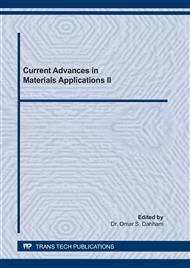[1]
P. Sivashanmugam, Application of nanofluids in heat transfer, in S.N. Kasi, An Overview of Heat Transfer Phenomena, Open access peer-reviewed, Edited vol., 2012, pp.7235-7328.
DOI: 10.5772/52496
Google Scholar
[2]
H.M. Ali, M.U. Sajid, A. Arshad, Heat transfer applications of TiO2 nanofluids, in Application of Titanium Dioxide, INTECH, open Science | open minds, 2017, pp.181-206.
DOI: 10.5772/intechopen.68602
Google Scholar
[3]
M.V. Narayanan, S.G. Rakesh, Nanofluids: A review on current scenario and future prospective, International Conference on Mechanical, Materials and Renewable Energy, IOP Conf. Series: Materials Science and Engineering, 377 (2018), 1-9.
DOI: 10.1088/1757-899x/377/1/012084
Google Scholar
[4]
M. Bahiraei, R. Rahmani, A. Yaghoobi, E. Khodabndeh, R. Mashayekhi, M. Amani, Recent research contributions concerning use of nanofluids in heat exchangers: A critical review, Applied Thermal Engineering, 133 (2018) 137-159.
DOI: 10.1016/j.applthermaleng.2018.01.041
Google Scholar
[5]
K.Y. Leong, R. Saidur, T.M.I. Mahlia, Y.H. Yau, Modelling of shell and tube heat recovery exchanger operated with nanofluid based coolants, Int. J. Heat Mass Transfer, 55 (2012) 808-816.
DOI: 10.1016/j.ijheatmasstransfer.2011.10.027
Google Scholar
[6]
J. Albadr, S. Tayal, M. Alasadi, Heat transfer through heat exchanger using Al2O3 nanofluid at different concentrations, Case Studies in Thermal Engineering, 1 (2013) 38-44.
DOI: 10.1016/j.csite.2013.08.004
Google Scholar
[7]
S. Bhanuteja, D. Azad, Thermal performance and flow analysis of nanofluids in a shell and tube heat exchanger, Int. J. Mechanical Engineering and Technology, 4 (2013) 164-172.
Google Scholar
[8]
I.M. Shahrul, I.M. Mahbubul, R. Saidur, S.S. Khaleduzzaman, M.F.M. Sabri, M.M. Rahman, Effectiveness study of a shell and tube heat exchanger operated with nanofluids at different mass flow rates, J. Numerical Heat Transfer, Part A: Applications> An Int. J. Computation and Methodology, 65 (2014) 699-713.
DOI: 10.1080/10407782.2013.846196
Google Scholar
[9]
T. Srinivas, A.V. Vinod, Heat transfer enhancement using CuO/Water nanofluid in a shell and helical coil heat exchanger, International Conference on Computational Heat and Mass Transfer 2015, Procedia Engineering, 127(2015) 1271-1277.
DOI: 10.1016/j.proeng.2015.11.483
Google Scholar
[10]
P.K. Pandey, P.K. Lakhani, K. Kumar, P. Bohra, R. Mishra, Heat transfer analysis of shell and tube heat exchanger using Al2O3/SiC nanofluid, European J. Advances in Engineering and Technology, 4 (2017), 608-616.
Google Scholar
[11]
M. Sakthivel, A. Harikrishna, K. Satyadeep, B. Vineeth, Fluent analysis of shell and tube heat exchanger using nanofluids, Int. J. Mechanical Engineering and Technology, 9 (2018) 185-191.
Google Scholar
[12]
V. Nikkhah, SH. Nakhjavani, Thermal performance of a micro heat exchanger working with zirconia-based nanofluids for industrial cooling, Int. J. Industrial Chemistry, 10 (2019), 193 - 204.
DOI: 10.1007/s40090-019-0183-6
Google Scholar
[13]
D. Mansoury, F.I. Doshmanziari, A. Kiani, A.J. Chamkha, M. Sharifpur, Heat transfer and flow characteristics of Al2O3/Water nanofluid in various heat exchangers: Experiments on counter flow, J. Heat Transfer Engineering, 41 (2020), 220-234.
DOI: 10.1080/01457632.2018.1528051
Google Scholar
[14]
J.P. Holman, Heat Transfer, tenth ed., McGraw-Hill, New York, (2010).
Google Scholar
[15]
F.P. Incropera, D.P. Dewitt, T.L. Bergman, A.S. Lavine, Fundamentals of Heat and Mass Transfer, seventh ed., John Wiley & Sons, USA, (2011).
Google Scholar
[16]
M. Sajjad, H. Ali, M.S. Kamran, Thermal-hydraulic analysis of water based ZrO2 nanofluids in segmental baffled shell and tube heat exchangers, Thermal Science, 24 (2020), 1195-1205.
DOI: 10.2298/tsci180615291s
Google Scholar


